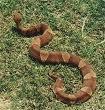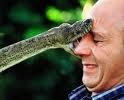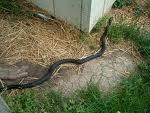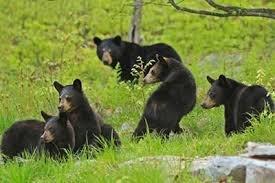Snakes!
 Nature: USA SNAKES- some eat you; some bite you, some save you. Here at Back2theLand wilds we have all sorts of snakes. Only two varieties are poisonous: the Rattlesnake and the Copperhead. The others are very beneficial, and mostly eat the poisonous snakes. As bites go I have been bitten several times-twice by poisonous ones.
Nature: USA SNAKES- some eat you; some bite you, some save you. Here at Back2theLand wilds we have all sorts of snakes. Only two varieties are poisonous: the Rattlesnake and the Copperhead. The others are very beneficial, and mostly eat the poisonous snakes. As bites go I have been bitten several times-twice by poisonous ones.
Since this article situs is in Floyd County- the heart of the Appalachian rural southeastern Virginia hills; also the world’s foremost ancient geological and rare herb repository in the world-save a China-Tibet area, it crawls with wonderful wildlife. Of course all this is slowly changing with developments and city expansions, but a few places remain as a reserve to the wildlife-mostly by backyard.
I have been involved with snakes since I was 14; then in Florida and trying to make money selling poisonous snakes to The Ross Allen Reptile Institute at Silver Springs back in the 1950’s. The big offer was a thousand dollars for an 8 foot Diamond Back Rattlesnake. Alas, I never attained that goal. When I came home after a weekend in the swamps with a bag of Cotton Mouth Water Moccasins and asked Mom to drive me to Silver Springs she shrieked! So I had the option of carrying them in a burlap bag on my motor scooter with my buddy holding them. Needless to say my financial entrepreneur dream was shattered; we let the snakes go in a local lake.
I did get a Florida 22-inch Coral snake that I made into a hatband for my Safari fantasies at that time. Coral snakes are banded color snakes with fixed fangs. They inject poison by chewing. Several NON-poisonous beneficial snakes have similar markings and eat Coral Snakes. A black tip nose best distinguishes the Coral snake. Actually we became quite good at catching snakes in those days but when I arrived in Viet Nam in the 60’s I was promptly bit by a Bamboo Viper. This is a small green-ridged snake with protruding purple russet red eyes. Very pretty- very distinguishable. In later years when I was dating Diane I took her on a canoe ride in the Dismal Swamp in Chesapeake Virginia and I was sure I saw one in a tree root. Anyway that was her last ride as a pile of spiders fell on her back unbeknown to her while I was brushing them off and pointing to some birds. On the way out I had a Cotton Mouth slither up into the canoe. I flipped it out and decided this might not be the date of her life- maybe my last date.
 A couple years ago a nice size Copperhead poision snake behind the Solar Greenhouse tagged me. Now these local snakes in common numbers are not great travelers and are stated to remain in a small radius as long as there are mice and crickets to eat. Fortunately the bite was a “dry” bite; meaning there was no poison burning through the tissue of my leg. However as with most all snakebites of poison, or non-poisonous, the mouth leaves bacteria. Then there is a local infection that needs cleaning and will be sore for a few days.
A couple years ago a nice size Copperhead poision snake behind the Solar Greenhouse tagged me. Now these local snakes in common numbers are not great travelers and are stated to remain in a small radius as long as there are mice and crickets to eat. Fortunately the bite was a “dry” bite; meaning there was no poison burning through the tissue of my leg. However as with most all snakebites of poison, or non-poisonous, the mouth leaves bacteria. Then there is a local infection that needs cleaning and will be sore for a few days.
The Viet Nam bite was informative as I was lucky to meet one of five Army Herpetologists at the time who examined the snake remains that my fellow Marine buddies had stomped into mush while I was sucking my finger and asking one of these stalwart men to cut my finger for me. One took faint. I thought it amusing and wondered was it a hemotoxin, or a neurotoxin snake that bit me.
The hemotoxin variety kills by injecting a poison that destroys the blood system-tissue, and the neurotoxin destroys by a paralytic poison. Fortunately it was the former.
The Good Doctor advised me in this case that the anti-venom treatment consisting of a series of shots around the upper arm would be more painful than the bite. He was right as my arm swelled up to a balloon and was extremely painful from the anti-venom. Of course today times and dosages may have changed. I prefer dry bites, well no bites are even better.
I would like to make a point clear. The Crocodile Hunter on TV was an experienced poisonous reptile handler, far, far better than I, and I am NOT about to handle poisonous snakes anymore. Elderly people, infants, and children are all susceptible to small poison dosage in their system. The sick, infirm are highly susceptible. Healthy adults will most likely lose body tissue, and become very sick endangering their heart for years to come. My strong advice is not to handle any snake. I am NOT going to tell you exactly how I handle the non-poison beneficial snakes as they bite too, if they can. I have a rule at this time, started when we had children. I will kill a poison snake-with regret- as one of God’s creatures-because it is dangerous as stated above. I use two things. One is my dog; and all dogs and cats will make a specific yipping sound when they spot a snake. They will circle the snake. I hear the racket and I intervene.
The last Rattlesnake I killed, years back I just looped its head off with a hoe. That gave me several feet of space as a Rattlesnake can move from a coiled position about 2/3rds its body length and open its jaws quite wide and with fangs one to 3inches in length it can penetrate your bony leg. A Rattlesnake does NOT always rattle a warning.
Please note the lead in picture above, currently floating about the eminent domain of the Internet. This was a Texas Diamondback rattlesnake over six feet long and could easily kill a horse. You are smaller than a horse. Snakes grow to huge sizes if they have a constant supply of food- snakes, rats, mice, insects, and small animals. This remained near a Hamburger Hut with a dumpster. It is a wonder some night that some worker did not get fatally tagged.
I usual carry a .22 magnum revolver on me with rat shot. Rat shot-snake shot is a common load if you want to buy it in all common calibers, over the counter, or in catalogs. Headshots are required. Snakes will bite even if they seem dead. Snakes will bite even if the head is separated from the body. Leave it alone. Don’t kick it, or pick it up. Leave it alone for hours.
IF YOU ARE BIT or YOUR CHILD IS BIT…. DO NOT RUN ARROUND IN A REVENGE MODE TO KILL THE SNAKE! You are just getting your heart pumping. Immediately walk calmly while applying shoelace-belt, or hand pressure above the bite. If you can get ICE- all the better! Pack ice around the bite and elevate the limb. Stay as quiet as you can. Let the medics take charge. Ignore everyone else running around in a panic. Dial 911. You might pre-call this summer and see if the hospital of choice has anti-venom.
The Doctors advised me at that time that cutting the bite was useless as the poison was in the blood stream. Sucking had limited success, although a recent snake bite victim who sought my advice had applied a potato poultice to a Copperhead bite- albeit a small one- when loading wood from a firewood pile-tagged in the finger. He had been in swollen and infected pain for a week. He refused medical treatment, not having insurance. We treated it with herbs for infection and pain reduction. His wife later lanced the pus at home. He recovered nicely. This was a 4’ snake. I strongly recommend competent medical consultation especially is you have medical health issues.
In this area there exists only indigenous Copperheads and Rattlesnakes- mostly smaller Timber rattlers, which in the fall are a bane to the hunters.
Now in the south, swamps and Everglades you have Copperheads, Rattlers- really big Diamondbacks, Coral snakes and Cottonmouths. The problem is these snakes, being beneficial to the ecology are disappearing. Well intentioned, but stupid people are dumping their collector pet snakes in the swamps. The worst of the pets are Reticulated Pythons that can easily obtain 50 feet. 23-foot pythons, now common, can swallow a child. They are eating everything that crawls, swims or walks. The losses in the Everglades is staggering. Alligators, birds, deer, Cougars are being decimated. This is mostly because Florida Commercial pet store monied interests are opposed to the Fish and Game managing these and other non-indigenous reptiles that are becoming beyond the pest stage. . I often recall that pretty look a like Bamboo Viper in the Dismal Swamp. I wonder how many Cobras, Browns, and such are dumped each year.
 For the pet owners I note many want to show how sweet their pets are and pick up the snake bringing it to face level kissing the snake. You are at serious risk. All snakes are predators and swallow their prey headfirst. Your head is a symbolic prey and when you think you have a docile snake it will lash out and bite you in the face. Those jaws can unhinge and the bite area is very, very big. Pythons have big jaws. Keep the snake in the tank. Teach safety handling to all visitors and especially children.
For the pet owners I note many want to show how sweet their pets are and pick up the snake bringing it to face level kissing the snake. You are at serious risk. All snakes are predators and swallow their prey headfirst. Your head is a symbolic prey and when you think you have a docile snake it will lash out and bite you in the face. Those jaws can unhinge and the bite area is very, very big. Pythons have big jaws. Keep the snake in the tank. Teach safety handling to all visitors and especially children.
You can purchase a pair of SNAKE BITE PROOF, or SNAKE BITE PREVENATIVE leg and foot wear on the Internet. I bough a nice safe pair of boots from www.sportsmansguide.com some years back. My advice is that they are heavy, hot and a bit small so I would recommend them for a wide foot purchase and not long walks. They also offer leg chaps. Police type Kevlar gloves are a consideration.
Down in the Caribbean tourist retreats in the bushes are offered. This means lots of big, really big, poisonous Fer-de-Lance Rattlesnake type snakes that lie about the trails. An interesting clip from National Geographic a couple years back related the story about a girl in a group that did not wear her boots and was bitten at night. She almost lost her leg, remaining with severe traumatic pain, deep tissue loss and scaring for several years.
Snake meat round ups with tail gate parties are commonplace these days for cookouts by adventurous Macho Men. Be careful of your children in these dangerous areas.
 Lastly there exists in this area very important BLACK SNAKES and other constrictors that hunt out, constrict, kill and eat Rattlesnakes and Copperheads. We have a yearly nest of Blacksnakes in this old Civil war era house above the kitchen. Each spring they slip out about May 1st, head for the wood shed, then return in the cooler months to the attic, lay eggs and grow fat on house mice. Most of the world has house snakes for this purpose so do not think me mad- just practical. When you see a Blacksnake on the road- avoid hitting it. It is valuable and may save your life.
Lastly there exists in this area very important BLACK SNAKES and other constrictors that hunt out, constrict, kill and eat Rattlesnakes and Copperheads. We have a yearly nest of Blacksnakes in this old Civil war era house above the kitchen. Each spring they slip out about May 1st, head for the wood shed, then return in the cooler months to the attic, lay eggs and grow fat on house mice. Most of the world has house snakes for this purpose so do not think me mad- just practical. When you see a Blacksnake on the road- avoid hitting it. It is valuable and may save your life.
SPECIAL ATTENTION: Our last incomplete article series on rifles and riflescopes invited a comment if you liked the series. No one commented. Should I just drop the series on firearms? If I do not hear from you, I will.
COPYRIGHT: 2010. Back2theLand.com, Mark Steel



